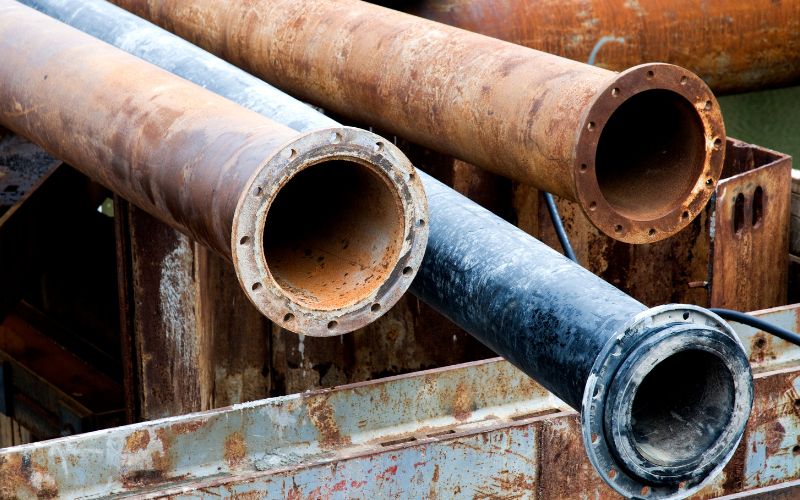New Haven Water Quality at a Glance
moderate concerns
Is New Haven Water Safe to Drink?
Generally Safe, With Some Concerns – New Haven water meets federal EPA standards but contains detectable levels of concerning contaminants. The Regional Water Authority serves 430,000 customers with water from 10 lakes and 3 aquifers. Key issues include PFAS “forever chemicals” detected at 3.5-11 ppt, trihalomethanes averaging 48 ppb (ranging 2-123 ppb), and hexavalent chromium. Connecticut’s unique prohibition on mixing drinking water and wastewater sources helps maintain better quality than many states.
⚠️ Key Concerns for New Haven Residents
- PFAS “Forever Chemicals”: Detected at 3.5-11 ppt across the system; some wells in Cheshire show levels above 4 ppt threshold
- Trihalomethanes (Disinfection Byproducts): Chloroform, bromodichloromethane averaging 48 ppb; formed when chlorine reacts with organic matter
- Hexavalent Chromium: Cancer-causing form of chromium detected; can come from natural deposits or industrial sources
- Source Water Protection: RWA actively manages 27,000+ acres of watershed land to minimize contamination risks
Read the full report below for detailed analysis, city-specific data, and actionable recommendations for New Haven residents.
New Haven – Connecticut – Water Quality Report 2025: PFAS Testing, Infrastructure Concerns & Safety across your city
The South Central Connecticut Regional Water Authority (RWA) provides comprehensive water services to approximately 430,000 residents across the greater New Haven metropolitan area, including the communities of Ansonia, Bethany, Branford, Cheshire, Derby, East Haven, Hamden, Milford, New Haven, North Branford, North Haven, Orange, Seymour, West Haven, and Woodbridge. Established as a nonprofit corporation in 1977, the system encompasses over 1,700 miles of water distribution lines, 10 reservoirs, three aquifers, and multiple state-of-the-art treatment facilities that deliver an average of 46 million gallons of drinking water daily to Connecticut’s second-largest metropolitan area.
RWA sources its drinking water from multiple reservoir systems including Lake Whitney, Saltonstall, West River, and North Branford reservoirs, along with wellfields that draw from the Quinnipiac, Mill River, and Housatonic River aquifers. The water undergoes comprehensive treatment at facilities including the Lake Whitney Water Treatment Plant in Hamden and other surface water treatment plants. RWA’s water consistently meets all federal and state quality standards, though the utility faces ongoing challenges with emerging contaminants like PFAS, infrastructure modernization, and climate adaptation. The authority has invested significantly in advanced treatment technologies, watershed protection covering over 27,000 acres, and customer assistance programs to ensure sustainable water supply for future generations.

New Haven Water Quality: Current Status (2024-2025)
Latest Testing Results
- Comprehensive Monitoring: RWA conducts over 100,000 drinking water tests annually across its system, collecting thousands of water samples to ensure the highest quality standards are maintained.
- Testing Scope: The authority tests for more than 70 regulated compounds and over 40 unregulated contaminants including lead, organic compounds, PFAS compounds, and disinfection byproducts throughout the distribution network.
- Compliance Status: RWA’s water consistently meets or exceeds all federal EPA and Connecticut Department of Public Health drinking water standards, maintaining full compliance with regulatory requirements.
Water Sources
- Primary Reservoirs: Over 80% of drinking water originates from ten lake reservoir systems located in Hamden, Woodbridge, East Haven, Bethany, Guilford, Madison, Killingworth, Branford and North Branford, providing reliable surface water supply.
- Aquifer Systems: Supplemental water comes from three wellfields drawing from Quinnipiac and Mill River Aquifers in Cheshire and Hamden, plus Housatonic River aquifer in Derby and Seymour.
- Watershed Protection: RWA manages over 27,000 acres of protected watershed land across multiple communities, maintaining natural filtration and pollution prevention measures.
Advanced Treatment Technology
- Treatment Facilities: Multiple state-of-the-art surface water treatment plants process water using multi-barrier treatment including coagulation, flocculation, sedimentation, filtration, and disinfection.
- Distribution System: RWA’s interconnected distribution system allows water from multiple sources to be delivered to neighborhoods, with blending capabilities to meet demand and ensure reliability.
- Laboratory Excellence: RWA operates one of only two Connecticut laboratories licensed to test for PFAS compounds, providing cutting-edge analytical capabilities for emerging contaminants.
Infrastructure Modernization
- Infrastructure Investments: Major infrastructure improvements including dam safety projects and treatment facility upgrades to meet modern safety and regulatory standards.
- Distribution Network: Ongoing modernization of over 1,700 miles of water mains and distribution infrastructure, with systematic replacement programs targeting aging components.
- Smart Technology: Implementation of advanced monitoring systems and real-time water quality tracking throughout the distribution network to enhance system reliability and customer service.
Customer Protection Initiatives
RWA provides extensive customer support through the Residential Water Assistance Program offering $80 grants for qualifying low-income customers, along with PipeSafe protection plans for water line repairs. The authority maintains transparent communication through annual water quality reports published in English and Spanish, and operates HazWaste Central, Connecticut’s only permanent household hazardous waste collection facility. RWA’s commitment includes proactive PFAS testing since 2019, comprehensive watershed protection, and customer education programs. The utility’s investments in treatment technology, source water protection, and customer assistance demonstrate dedication to providing safe, reliable drinking water while addressing emerging challenges including climate change, aging infrastructure, and evolving regulatory requirements.
Recommendations for New Haven Residents

Check Your Service Line
Use RWA’s service line inventory map to check if your property might have a water service line containing lead. Visit rwater.com to access the interactive map and learn about your specific address.

Practice Water Conservation
Follow RWA’s year-round conservation tips available at rwater.com/water-wise-ways. During drought conditions, shut down automatic irrigation systems and reduce non-essential water use to protect regional water supplies.

Consider PipeSafe Protection
Protect yourself from unexpected repair costs with RWA’s PipeSafe programs, offering coverage for water lines, sewer/septic systems, and in-home plumbing repairs at nominal fees.
Frequently Asked Questions
Is New Haven’s tap water safe to drink?
Yes, New Haven’s tap water meets or exceeds all federal EPA and Connecticut Department of Public Health drinking water standards. RWA’s water comes from protected reservoirs and aquifers that undergo comprehensive multi-barrier treatment.
RWA conducts over 100,000 water quality tests annually across its distribution system, testing for more than 70 regulated compounds and over 40 unregulated contaminants including bacteria, chemicals, and emerging contaminants like PFAS. The authority operates multiple state-of-the-art treatment facilities and maintains one of only two Connecticut laboratories licensed for PFAS testing. RWA’s commitment to transparency includes publishing annual water quality reports and proactive monitoring that exceeds regulatory requirements.
What is RWA doing about PFAS contamination?
RWA has been proactively testing for PFAS compounds since 2019 and operates one of only two Connecticut labs licensed for PFAS analysis. Current testing shows PFAS levels at 3.5-11 parts per trillion, with some Cheshire wells showing concentrations just above 4 ppt.
The authority monitors ten different PFAS compounds and has found concentrations just above 4 parts per trillion at some Cheshire wells (which supply only 3-5% of total water). RWA collaborates with Connecticut’s inter-agency task force and follows the latest scientific developments. As federal regulations are finalized requiring compliance by 2029, RWA continues investing in treatment technologies and source water protection to address these emerging contaminants while maintaining the safety and quality of drinking water.
How can I check if my service line contains lead?
RWA provides an online service line inventory map where customers can search their address to learn if their property might have a water service line containing lead.
• Online Map: Visit rwater.com to access the interactive service line inventory map by entering your address
• Customer Service: Call RWA at 203-562-4020 for additional information about your specific service line materials
• Water Testing: RWA’s laboratory can provide water quality testing services for customers with specific concerns
The authority actively monitors for lead and copper throughout the distribution system and uses corrosion control treatments to minimize leaching from older plumbing components. Most lead exposure in drinking water comes from customer-owned plumbing rather than RWA’s distribution system.
What financial assistance is available for water bills?
RWA offers the Residential Water Assistance Program providing one-time annual $80 grants for qualifying low-income customers:
Eligibility Requirements:
• Household income at or below 125% of Federal Poverty Guidelines (approximately $30,375 per year for a family of four)
• Account must be in the name of an adult currently living at the service address
• Residential single home or apartment served by its own water line
How to Apply:
Contact RWA at 203-562-4020 or visit rwater.com for application information. Applications are processed through community-based organizations on a first-come, first-served basis. Grants are applied directly to qualifying customer accounts and cannot be used for security deposits or reconnection fees.
Quality News About Your Water
Get the comprehensive water quality news coverage you need with our dedicated US Water News Service. From coast to coast, we deliver in-depth reporting and expert analysis on PFAS contamination, EPA regulatory changes, infrastructure developments, and emerging water safety issues affecting communities nationwide. While mainstream media only covers the biggest stories, we provide the detailed, ongoing coverage that helps you understand the full scope of America’s water challenges. Whether you’re a concerned citizen, water professional, or community leader, our daily updates and analytical insights keep you informed about the issues that matter most to public health and environmental safety.
Contaminants of Concern

PFAS Compounds
Source: Per- and polyfluoroalkyl substances from industrial processes, firefighting foams, and consumer products that can enter water sources through environmental contamination
Health Effects: Research suggests potential impacts on immune system, thyroid function, cholesterol levels, and reproductive health, with possible links to certain cancers
Current Status: RWA testing since 2019 shows PFAS levels at 3.5-11 parts per trillion; concentrations just above 4 ppt detected at some Cheshire wells supplying 3-5% of water EPA Limits: New federal regulations require monitoring by 2027 and compliance by 2029

Disinfection Byproducts
Source: Formed when disinfectants react with naturally occurring organic matter in source water; levels can vary seasonally with water temperature and organic content
Health Effects: Long-term exposure to elevated levels may increase risk of certain cancers and potentially affect liver, kidney, and central nervous system function
Current Status: Monitored regularly throughout the distribution system with trihalomethane levels averaging 48 ppb (ranging 2-123 ppb), maintained below EPA maximum contaminant levels EPA Limits: 80 ppb for total trihalomethanes and 60 ppb for haloacetic acids
Please read – our information
The information presented on cleanairandwater.net is compiled from official water quality reports, trusted news sources, government websites, and public health resources. While we strive for accuracy and thoroughness in our presentations, we are not scientists, engineers, or qualified water quality professionals.
Our mission is to present water quality information in an accessible, real-world format that helps people understand what’s in their water and make informed decisions about their health and safety. We believe that complex environmental information should be available to everyone in a format that’s easy to understand.
We make every effort to ensure our content is current and accurate, but we cannot guarantee that all information is complete or error-free. This website should not replace official communications from your local water utility or health department. We always recommend consulting official sources for the most up-to-date information regarding your specific water system.
Clean Air and Water is not liable for any unintentional errors, omissions, or outdated information. The content on this site is provided for informational purposes only and should not be considered professional advice.


